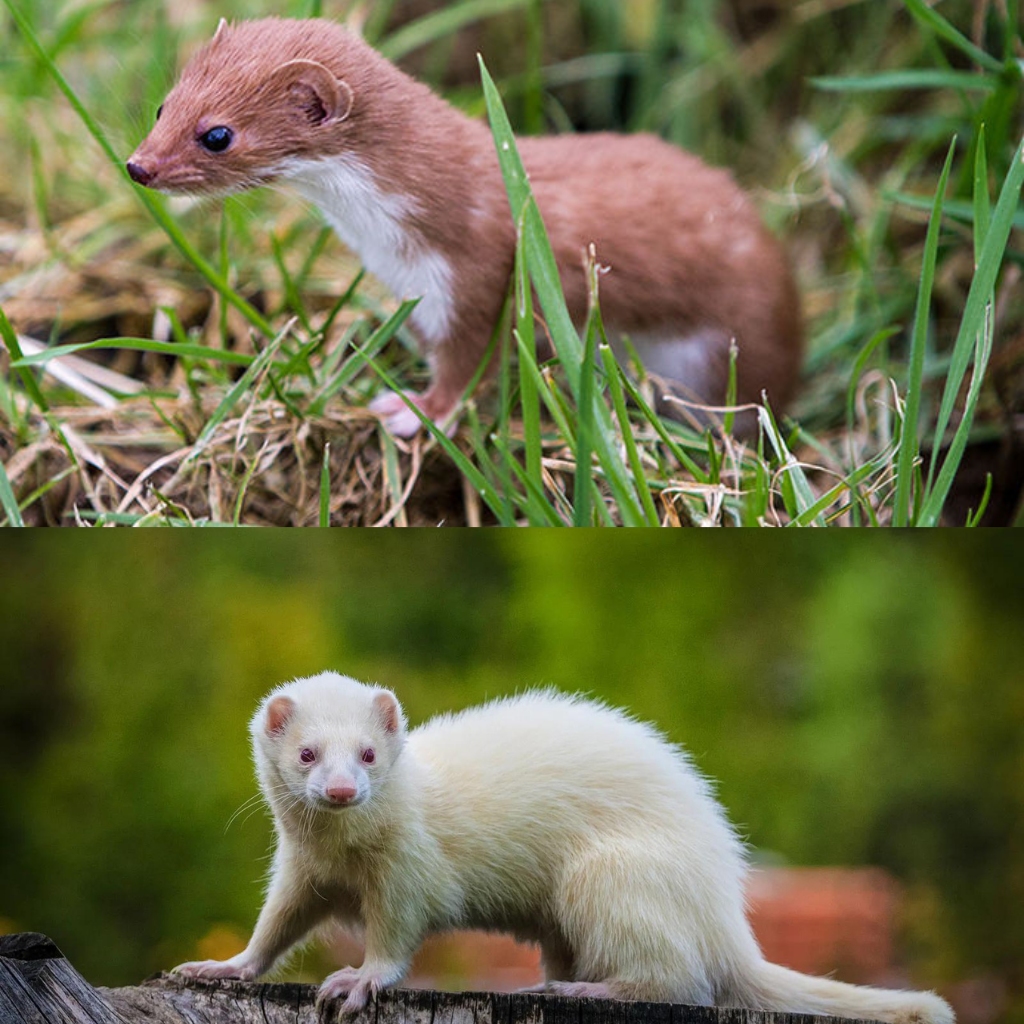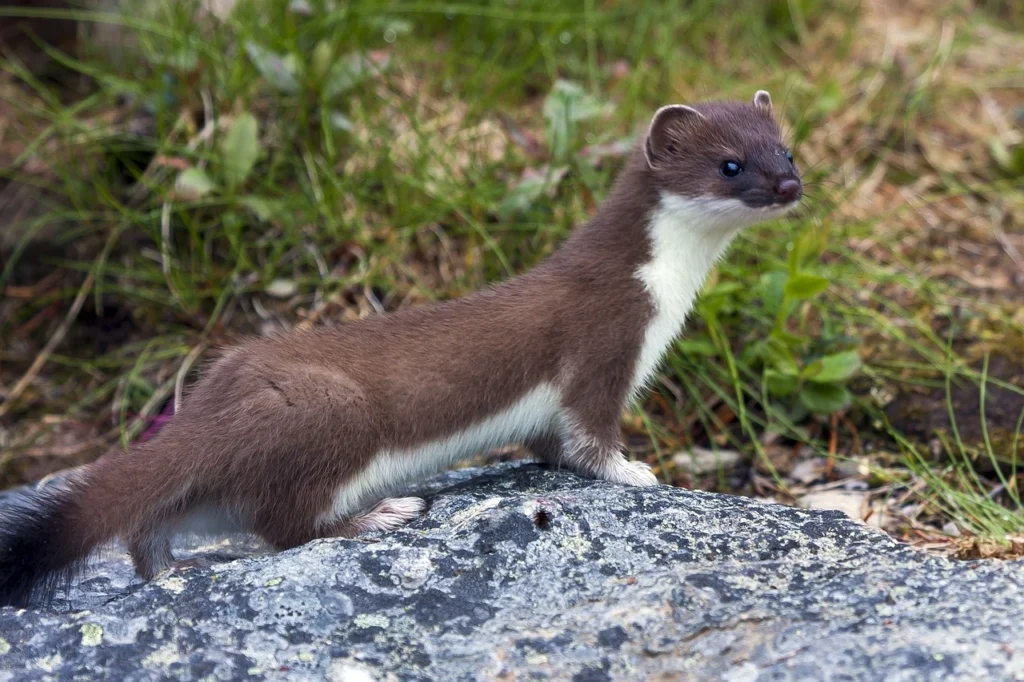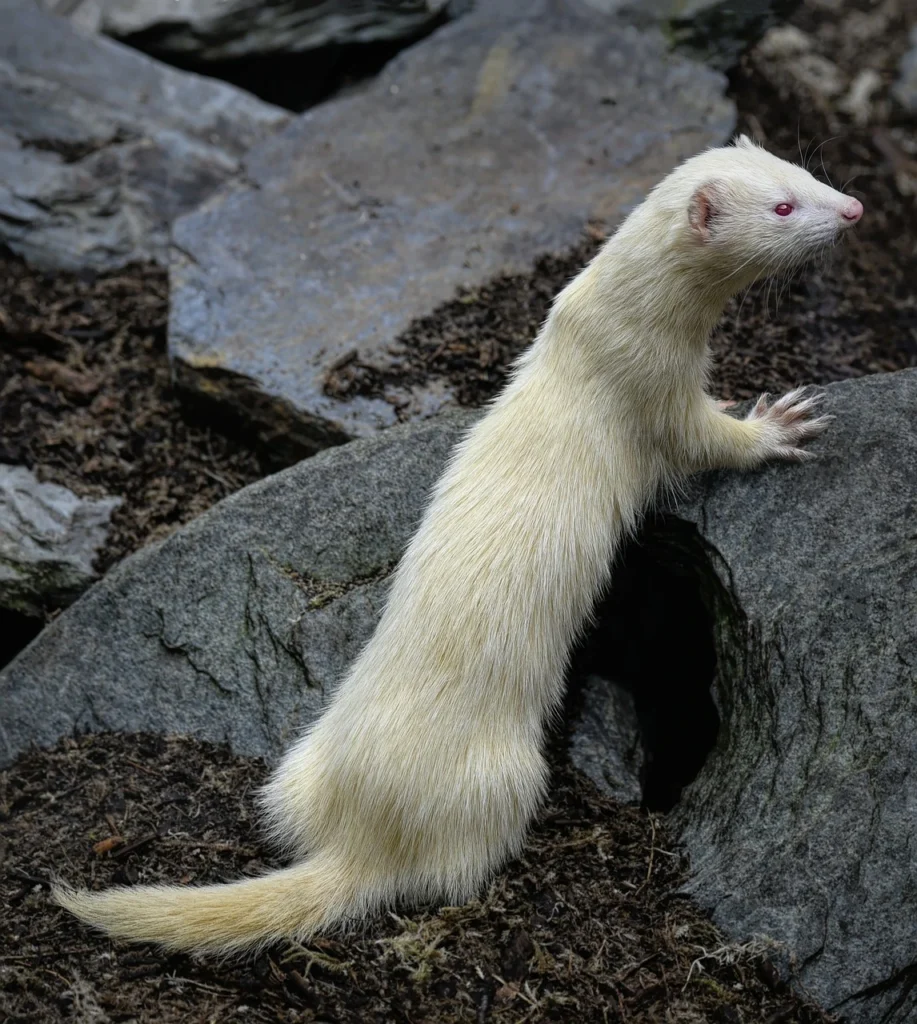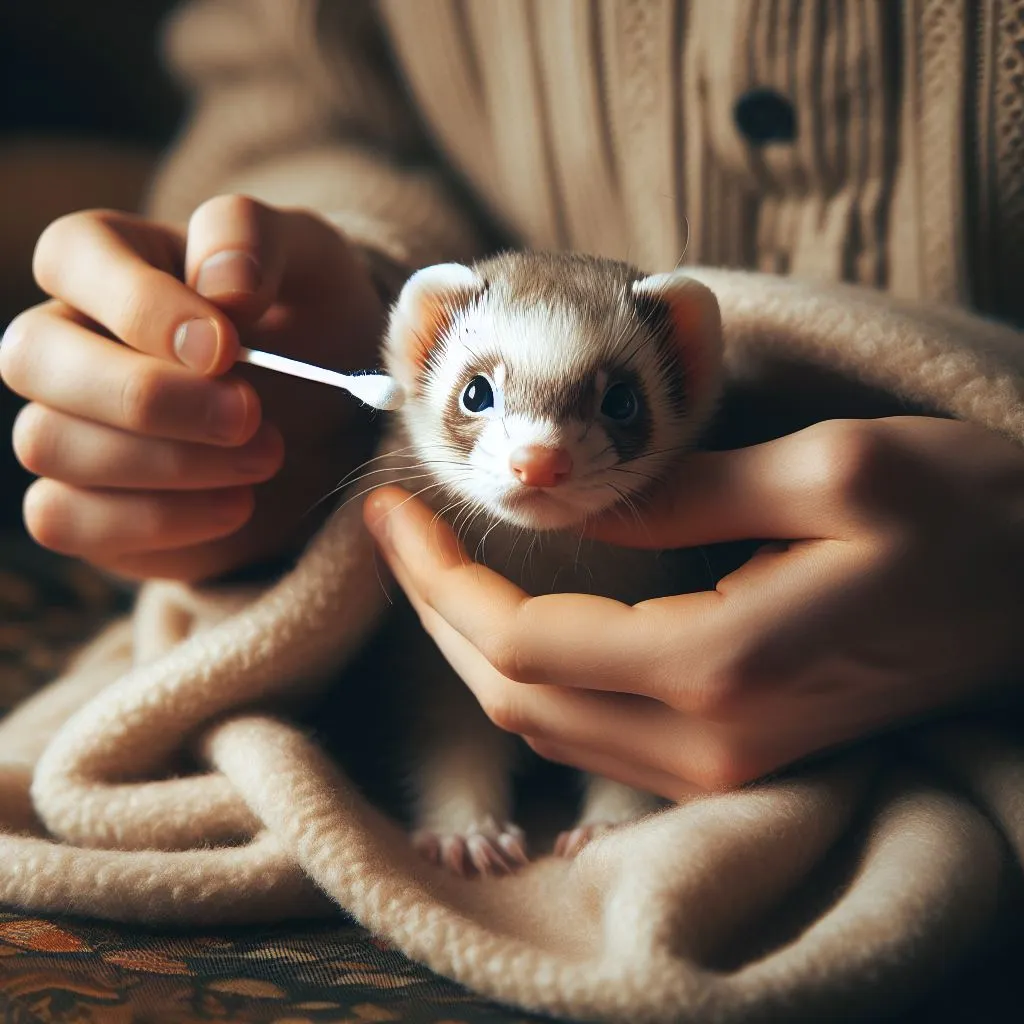Weasels Vs Ferrets | The 9 Key Differences Among Them

Weasels vs ferrets – a comparison that sparks curiosity among animal enthusiasts. These small carnivorous mammals share similarities but also have distinct differences in their behaviour, physical characteristics, and domestication history.
Understanding the contrast between these creatures provides valuable insights for pet owners, wildlife observers, and those interested in zoology.
Key Differences Between Weasels And Ferrets
| Aspect | Weasels | Ferrets |
|---|---|---|
| Body Shapes | Long, slender bodies with short legs | Similar body shape, larger in size |
| Size and Weight | 7-12 inches, 1-8 ounces | Up to 20 inches, 1.5-4 pounds |
| Coat Colours | Reddish-brown, various colors | Broad range, including albino, sable, cream |
| Social Interaction | Solitary, territorial | Highly social, thrive on companionship |
| Mindset | Independent mindset | Sociable mindset, seek interaction |
| Diet Preferences | Small mammals, birds, eggs | Carnivores with specific dietary requirements |
| Habitats and Distribution | Woodlands, diverse environments worldwide | Domestic pets, also found in the wild |
| Domestication and Suitability as Pets | Not suitable due to wild nature and hunting instincts | Domesticated, suitable with proper care and training |
| Conservation Status | Least concern (various species) | European polecat faces challenges in some regions |
Topics Covered In This Article
- Key Differences Between Weasels And Ferrets
- Defining Weasels and Ferrets
- 1. Physical Characteristics Comparison
- 2. Coat Colour and Body Size Variances
- 3. Behavioural Habits and Personality Differences
- 4. Diet Preferences and Feeding Habits
- 5. Habitats and Distribution Across the Globe
- 6. Domestication and Suitability as Pets
- 7. Conservation Status and Endangered Concerns
- Summary
- Frequently Asked Questions
Defining Weasels and Ferrets
Characteristics
Weasels are small carnivorous mammals, known for their long, slender bodies and short legs. They belong to the Mustelidae family and are adept hunters, preying on small rodents and rabbits.
On the other hand, ferrets are domesticated versions of the European polecat. They also fall under the Mustelidae family but have been selectively bred over centuries for a more docile temperament.
Weasels typically have a reddish-brown coat with white or yellow underbellies, while ferrets come in various colours due to selective breeding.
Both animals have scent glands used for marking territory and communicating with others of their species. While weasels tend to be solitary creatures, ferrets are social animals that thrive on companionship.
Habitat and Behaviour
In terms of habitat, weasels prefer living in woodland areas where they can find ample prey such as mice and voles. They often make dens in hollow logs or abandoned burrows.
Conversely, ferrets are commonly found as pets in homes around the world but still retain some wild instincts from their polecat ancestors.
Both animals exhibit similar behaviours. However, domesticated ferrets may display more playful behaviour due to interactions with humans.
1. Physical Characteristics Comparison
Body Shapes

Weasels have long, slender bodies with short legs, while ferrets share a similar body shape but are larger in size. Both animals are built for agility and speed.
Weasels have a reddish-brown coat, whereas ferrets come in various colours such as albino, sable, or cream. This difference in coat colour allows them to adapt well to their respective habitats.
Size and Weight

Weasels typically measure around 7-12 inches in length and weigh between 1-8 ounces. On the other hand, ferrets can grow up to 20 inches long and weigh between 1.5-4 pounds. This significant size disparity is notable when comparing the two animals side by side.
The slight variations in physical characteristics contribute to these animals’ distinct behaviours and roles within their ecosystems.
2. Coat Colour and Body Size Variances
Coat Colours
Weasels display a variety of coat colours, such as white, black, and brown. On the other hand, ferrets can have coats in shades of sable, albino, or silver. This means weasels come in a broader range of coat colours compared to ferrets.
Weasels’ coat colours allow them to blend into their surroundings for camouflage. For instance, the white-coated weasel is well-camouflaged in snowy environments. Ferrets’ distinct coat colours are often bred selectively by humans for aesthetic purposes.
Both animals boast unique features that make them distinctive from each other based on their coat colour variations.
Body Size Differences

In terms of body size, weasels are smaller than ferrets. Weasels typically measure around 6 to 8 inches in length and have slender bodies which enable them to move swiftly through narrow spaces like burrows or dense vegetation.

Ferrets are notably larger than weasels due to their domestication process over time. Their average length ranges between 20-24 inches when fully grown. The difference in body size also impacts their behaviour and lifestyle; for example, it affects the type of prey they hunt and how they navigate different terrains.
3. Behavioural Habits and Personality Differences
Social Interaction
Weasels are solitary creatures, preferring to live alone and defend their territory. They spend most of their time hunting for food and avoiding other animals.

On the other hand, ferrets are highly social animals that enjoy spending time with humans and other ferrets. They thrive in interactive environments, exhibiting playful behaviour when engaged with toys or companions.
Ferrets often display curiosity towards new objects or people, showcasing a friendly and inquisitive nature. In contrast, weasels focus on agility and speed as they hunt for prey while evading potential threats in their solitary lifestyle.
Mindset Variances
The difference in the behavioural habits of weasels versus ferrets can be attributed to their distinct mindsets. Weasels have an independent mindset due to their solitary nature, whereas ferrets possess a more sociable mindset stemming from their preference for interaction with others.
While weasels exhibit territorial behaviour as a survival instinct, ferrets seek connection through playfulness and interaction with both humans and fellow ferrets. These distinctive mindsets lead to varying personality traits between the two species.
4. Diet Preferences and Feeding Habits
Weasels’ Dietary Habits
Weasels have a diet that primarily consists of small mammals, birds, and eggs. They are skilled hunters, preying on creatures smaller than themselves. Weasels need to eat frequently due to their high metabolic rates.
Weasels are carnivores, which means they thrive on a diet rich in meat-based protein. Their bodies are designed for hunting and consuming animal flesh as their primary source of nutrition.
Ferrets’ Nutritional Needs
Similar to weasels, ferrets are also carnivores with high metabolic rates. However, domesticated ferrets have specific dietary requirements that differ from those of wild weasels.
Ferrets require a balanced diet that includes high-quality commercial ferret food or raw meat diets specifically formulated for them .This ensures they receive the necessary nutrients for optimal health and well-being.
Both weasels and ferrets share the common trait of needing frequent feeding due to their high metabolic rates. While wild weasels hunt for small mammals, birds, and eggs in their natural habitat, domesticated ferrets rely on specially formulated diets provided by their owners.
5. Habitats and Distribution Across the Globe
Weasels’ Diverse Environments
Weasels are highly adaptable creatures that can thrive in various habitats, including woodlands, grasslands, and even urban areas. They are skilled hunters, preying on small mammals, birds, and insects. Their ability to live in diverse environments makes them a common sight across different parts of the world.
Weasels can be found in Europe, Asia, Africa, and North America due to their remarkable adaptability to various regions. In these areas, they navigate through forests and open fields with ease as they hunt for their prey. These nimble creatures often make use of existing burrows or create their own dens within the ground for shelter.
Ferrets: From Pets to Wild Settings
Ferrets are commonly known as domestic pets but also exist in the wild in some regions. As pets, ferrets often live alongside humans in domestic settings where they are cared for by their owners. However, it’s important to note that ferrets have also been introduced into the wild in certain areas where local laws permit such ownership.
In contrast to weasels’ widespread distribution across continents, ferrets primarily inhabit human dwellings but can also be found living independently when released into suitable environments. This unique dual existence showcases how ferrets have adapted from being domesticated animals to thriving as semi-wild creatures.
6. Domestication and Suitability as Pets
Weasels as Pets
Weasels are not typically kept as pets due to their wild nature. They are small, carnivorous mammals that are skilled hunters, making them unsuitable for domestic life. Weasels have a strong hunting instinct and may pose a threat to other household pets such as cats or small rodents.
Weasels’ natural behaviour involves solitary living and burrowing activities, which makes them challenging to accommodate in a human home environment. Their inclination towards hunting also means they require ample space for exercise and mental stimulation, which can be difficult to provide in captivity.
Ferrets as Pets
Ferrets, on the other hand, have been domesticated for thousands of years and make affectionate pets when properly cared for. These playful animals thrive in social environments with humans and other ferrets. With proper training and socialisation, ferrets can adapt well to living in a domestic setting.
Ferrets require dedicated training and socialisation to thrive in a domestic environment. This includes litter training, handling exercises, regular playtime outside of their enclosure, and exposure to various stimuli like different sounds and smells. When given the right care and attention, ferrets can become cherished members of the household.
7. Conservation Status and Endangered Concerns
IUCN Listing
Some species of weasels are listed as least concern by the IUCN due to their wide distribution. This means that they are not currently facing significant threats to their survival. However, it’s important to note that this status can change based on various factors such as habitat loss and climate change.
Weasels’ ability to adapt to different environments has contributed to their widespread presence, leading them to be classified under the “least concern” category. This indicates that these animals have a relatively stable population across their range.
European Polecat Challenges
The European polecat, from which ferrets originated, faces conservation challenges in certain regions. Habitat loss and human encroachment pose threats to both weasel and ferret populations, including the European polecat.
In some areas of Europe, polecats have experienced declines due to changes in agricultural practices and urbanization impacting their natural habitats. These challenges have implications for the broader ecosystem since polecats play a role in controlling rodent populations.
Summary
The comparison between weasels and ferrets reveals significant differences in their physical characteristics, behavioural habits, diet preferences, habitats, and domestication suitability. Understanding these distinctions is crucial for individuals considering them as pets or for conservation efforts. By recognising the unique traits of each species, one can make informed decisions about their care and protection.
For those intrigued by these fascinating creatures, further exploration into their world can be both enriching and beneficial. Whether it involves delving deeper into their natural habitats or advocating for their conservation, there are numerous opportunities to contribute to the welfare of weasels and ferrets.
Frequently Asked Questions
Weasels are wild carnivores, while ferrets have been domesticated for hundreds of years. Weasels have a long, slender body with a bushy tail, whereas ferrets have a more elongated body with a longer tail.
Yes, weasels typically have brown fur on their backs and white fur on their bellies. Ferrets come in various colours including albino, sable, silver, and cinnamon.
Weasels are solitary animals known for their agility and hunting skills. Ferrets are social creatures that enjoy interacting with humans as well as other animals.
Weasels primarily feed on small mammals like rabbits, rodents, birds, eggs etc., while domesticated ferrets consume specially formulated diets consisting mainly of meat-based products.
Weasel species inhabit various environments such as woodlands, grasslands or urban areas across Europe, Asia & North America. Domesticated pet ferrets can be found worldwide due to their popularity as pets.
Last Updated on 23 January 2024
Waman Nuka is a seasoned wordsmith and a passionate animal enthusiast with decades of experience in the world of animal care. With a deep love for all creatures great and small, Waman’s journey in the realm of animals started as a young boy exploring the lush forests surrounding his childhood home.


